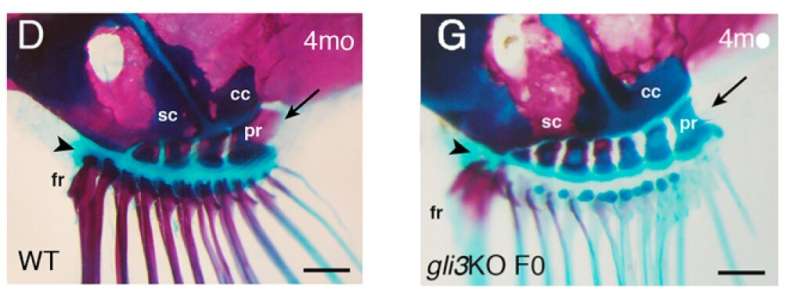Genetic analysis uncovers shared evolutionary history of fish fins and vertebrate limbs

All vertebrates have the same basic body plan: Head, spine, four appendages. Those appendages vary greatly in size, shape, and function, of course—from fins to wings, arms, and legs—but a new genetic analysis shows that genes that control development at the ends of the appendages share a deep evolutionary history.
In a study published this week in the Proceedings of the National Academy of Sciences, researchers from the University of Chicago and the Andalusian Center for Developmental Biology in Spain used genetic editing tools to show how a gene that controls the growth of bones at the terminal end of fish fins play the same role in forming fingers and toes in four-legged creatures. The same gene also controls this process both in paired fins, which are the progenitors to limbs, and the single, unpaired dorsal fin common to all fish that evolved before paired fins. This suggests that the last common ancestor between ray- and lobe-finned fish nearly 500 million years ago already had the genetic toolkit to shape their appendages, shared to this day by fish and four-legged vertebrates.
"There's this deep homology or similarity between fins and limbs, something ancient in structures that really don't look alike," said Neil Shubin, Ph.D., the Robert R. Bensley Distinguished Service Professor of Anatomy at UChicago and co-author of the new study. "We're showing a deeply conserved, deeply ancient and preserved gene function that's been around for hundreds of millions of years in vastly different structures. So, the molecular toolkit is ancient, and it does the same thing in different kinds of animals."
The study is a continuation of a collaboration between Shubin and the late José Luis Gómez-Skarmeta from Spain, which began at the UChicago-affiliated Marine Biological Laboratory in Wood Hole, Massachusetts. In 2018, they published a study that tracked the expression of the Sonic hedgehog (Shh) gene, which is widely used in a variety of basic biological functions, but especially important in the formation of limbs. In that study, they identified a combination of genetic enhancers that controlled development of limbs in mice but affect dorsal and paired fins in fish separately.
In the new research, Shubin, Gómez-Skarmeta, and Joaquin Letelier, also of the Andalusian Center, focused on another gene that works with Shh called gli3. This gene is already known to pattern the digits in a limb, helping determine the identity of each from thumb to pinky. Humans who have a mutation in gli3 often grow extra digits, what's called polydactyly, and mice who have gli3 knocked out in the lab also grow extra digits. The researchers wanted to see if gli3 worked the same way in fish, so they used CRISPR gene-editing tools to knock it out in the medaka, a small, popular aquarium fish also known as a Japanese rice fish. The gli3-knockout fish also developed the fish version of polydactyly, with multiple radial bones at the base of the fin and more fin rays. Interestingly, this happened in the paired pectoral and pelvic fins (the fish analog to limbs) and the unpaired, evolutionarily older, single dorsal fin as well.
Research in mice and chicken embryos shows that gli3 is involved in the process of cell proliferation, which makes sense for its role in polydactyly; if knocking out the gene causes more cells to grow in the appendage, it will also lead to more digits. Further genetic analysis in the fish showed that gli3 was also involved in cell proliferation in the fins, which suggests strong evolutionary similarities across species. As later terrestrial animals developed more advanced limbs, gli3 took on a more specialized role to control their shape and patterning.
"The speculation is that you have a primitive function of gli3 present in all vertebrate appendages ever since about 500 million years ago, and that was to promote proliferation, or the number of cells and hence the number of bones in the terminal end," Shubin said. "When paired fins arose it was already there, so gli3 was co-opted and gained a new role, which is anterior/posterior patterning."
Shubin says powerful new genetic tools like CRISPR and sequencing continue to allow scientists to track down more fascinating clues like this about the deep, shared history of all vertebrates.
"We all share a certain genetic toolkit, even though the anatomy may look very different in adult stages. We're finding these hidden, but very important, mechanistic similarities," he said. "It's really only with the benefit of the ability to do CRISPR for knockouts and the ability to do sequencing that we can really see these things at all. It's showing an underlying architectural and genetic ground plan for a diverse set of appendages in all vertebrates."
More information: Jose Luis Gómez-Skarmeta et al, The Shh/Gli3 gene regulatory network precedes the origin of paired fins and reveals the deep homology between distal fins and digits, Proceedings of the National Academy of Sciences (2021). DOI: 10.1073/pnas.2100575118.
Journal information: Proceedings of the National Academy of Sciences
Provided by University of Chicago Medical Center



















